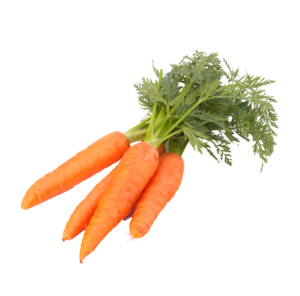Do You Eat Close to 17 Pounds of Carrots a Year?

By Reed Mangels, PhD, RD
If you’ve ever wondered if your vegetable consumption is similar to that of the average American, you will enjoy scrolling through reports from the United States Department of Agriculture (USDA). The USDA keeps records of how much food is available each year, on average, for each person in the United States. They do this by tracking domestic production, initial inventories, and imports of a particular food (for example broccoli) and then subtracting exports and end-of-year inventories. The national supply is divided by the U.S. population to calculate an estimate of food availability per person. While these estimates of food availability cannot tell us how much of a food an individual person eats, they provide an estimate of what is available for the average American individual. These estimates can be used to identify trends in food production.
The most recent report looks at the years 2000 to 2019. The part of the report that examines vegetables shows that over these two decades, the total amount of vegetables available decreased by 4 percent from 417.4 pounds per capita to 400.1 pounds. These totals include fresh, frozen, canned, and dried forms of vegetables.
The largest increase in vegetable availability was in the red and orange subgroup which includes sweet potatoes, chile peppers, and bell peppers. In 2019, 49 pounds of these foods were available per capita, compared to 35.1 pounds in 2000. Dark green vegetable availability also increased going from 21.7 pounds per capita in 2000 to 27.5 pounds in 2019. This subgroup includes broccoli, kale, spinach, and romaine and leaf lettuce.
More legumes were available in 2019 – 11.1 pounds per capita compared to 8.5 pounds per capita in 2000.
It’s encouraging to see that more red and orange and dark green vegetables and legumes are available since these are important sources of nutrients such as vitamin A, vitamin C, iron, and zinc.
Other vegetables with greater availability over the past 20 years include
- Asparagus 1.3 lbs/capita à 1.9 lbs/capita
- Brussels sprouts 0.3 lbs/capita à 0.8 lbs/capita
- Carrots 13 lbs/capita à 16.6 lbs/capita
- Kale 0.4 lbs/capita à 1.1 lbs/capita
- Squash 4.4 lbs/capita à 5.9 lbs/capita
And with lower availability:
- Lima beans 0.56 lbs/capita à 0.37 lbs/capita
- Cabbage 10.3 lbs/capita à 7.1 lbs/capita
- Corn 27.1 lbs/capita à 18.9 lbs/capita
- Green peas 3.7 lbs/capita à 1.9 lbs/capita
- White potatoes 138 lbs/capita à 119.1 lbs/capita
It’s fun to speculate about what led to these changes.
Resources
https://www.ers.usda.gov/data-products/food-availability-per-capita-data-system/
